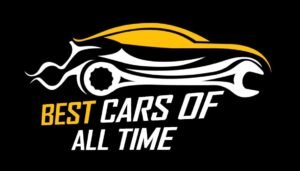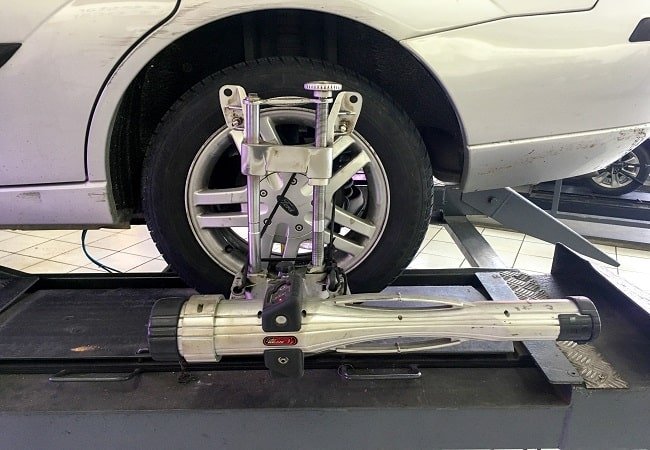Driving can be smoother and more enjoyable when your car is properly aligned. Also, it can lower your risk of accidents and help you save money on fuel. With the correct tools and experience, fixing car alignment can be a relatively simple and wonderful way to save money.
For such a simple task, you must first know what car alignment is and why it is important. Using simple tools, you can quickly fix your car’s alignment and ensure smooth operation. Now you must learn about these simple steps and tools to fix car alignment. This article will discuss the working methods to align your car correctly.
What Are The Types Of Car Alignment?

There are mainly three types of car alignment, front-end, thrust, and four-wheel. What kind of alignment your automobile will get depends on its suspension type. Your mechanic might suggest the ideal alignment type for your car.
Front-end Alignment
The front axle is adjusted during a front-end alignment. The most fundamental alignment method is only sometimes advised for use with contemporary automobiles.
Thrust Alignment
To ensure that all four wheels are parallel, a thrust alignment combines a front-end alignment with a thrust alignment. Usually, a solid rear axle vehicle requires this kind of adjustment.
Four-wheel Alignment
All-wheel drive, four-wheel drive, and front-wheel drive vehicles with adjustable or independent rear suspensions often require a four-wheel alignment.
Explanation Of Car Alignment And Its Importance

A vehicle’s suspension, which is the mechanism that connects a car to its wheels, is adjusted during alignment. It does not involve changing the wheels or tires themselves. Changing the angles at which the tires contact the road is essential for appropriate alignment.
The alignment of the wheels and tires is important. If they aren’t, you risk causing tire damage and altering how the car handles. Your automobile may have to work harder on the tires than it has to if the suspension is out of alignment because of unequal tire pressure.
The tires may eventually become worn on one side due to that resistance, causing them to wear unevenly. Driving on uneven tires is risky, and you could buy tires sooner than you would have had to with a perfect alignment.
Mention Of Common Alignment Problems

The performance and efficiency of a vehicle will improve with appropriate alignment. A wheel alignment can be the thing that saves your life if you have to make a sudden turn or dodge something on the road. The problems occur if you need to learn how to fix car alignment properly. Some of the common alignment problems are described below.
Uneven Steering Wheel
The car’s steering wheel should always remain straight and not off-center while traveling on a flat and straight route. The steering wheel is uneven, and the car requires a wheel adjustment if the emblem tips a few degrees off level in either direction.
Loose Steering
A loose or sloppy steering wheel can be highly dangerous because it can slow turning reaction time. Misaligned wheels can set on this and should always make you take your car to repair.
Uneven Tire Wear
Your car’s wheels may need to be aligned if you find that some of the treads on certain tires are wearing down more quickly than others. Tire scalloping, severe inner tire wear, or excessive outside tire wear are all examples.
Car Alignment Symptoms
Symptoms of Alignment Problems
You can recognize a few common symptoms when your car needs an alignment. One or more of the alignment problems listed below may be present:
Noisy Steering
If the steering wheel shakes while the car moves, the tires are probably out of alignment or imbalanced. Yet, a steering wheel’s shaking could also signify more significant issues.
Pulling To The Left Or Right
If the car continues to veer to the side, the wheels must be adjusted. The alignment is worse the more it deviates from a straight line. If you notice this issue, take your vehicle to repair as soon as possible and get an alignment performed.
Squealing Tires
The tires may begin to squeal as the car accelerates or turns because of uneven tire wear caused by a misalignment. Check the car if you hear squealing because other factors, such as worn brake pads, could cause it.
Camber, toe, and caster
A technician’s primary focus while examining your tire alignment is on three factors:
Camber
When viewed from the front of the car, this is the tire’s inward or outward angle. Incorrect alignment is indicated by excessive inward or outward tilt, also known as positive or negative camber, and requires adjusting. Worn bearings, ball joints, and other wheel-suspension components can cause camber misalignment.
Toe
Proper toe is essential for even tire wear and longer tire life. Toe alignment, instead of camber alignment, refers to how much the curve of your tires inside or outward when viewed from above. Just get up and gaze down at your feet if that’s unclear. They should be angled inward toward your body’s center.
Caster
The caster angle you choose assists in balanced cornering, stability, and steering.It is a special term that refers to the angle that may be observed when looking at the steering axis from the side of the vehicle.
The steering axis will lean toward the driver if you have a positive caster. Casters help you keep your car on a straight path and assist with the steering wheel’s return to a straight position following a turn.
Checking Tire Pressure And Inspecting The Tire
Use a tire pressure tester to verify that your tires are properly inflated. Then, add air to the tires as necessary. Remove the valve stem cap, press the gauge head evenly onto the valve stem, and apply firm pressure until the hissing sound ceases to check your pressure. Check the pressure by removing the gauge.
You should check your tires for any damage or circumstances that might require their replacement in addition to the tread depth and inflation pressure. Check for any cuts, scrapes, punctures, bulges, lumps, or cracks in the tread and sidewalls. Go to a tire service center if you see anything suspicious.
Checking Suspension Components
Springs, shocks, struts, bushings, control arms, strut rods, and the sway bar are common suspension parts. Regular suspension system inspections and complete wheel alignments should be performed on your car at least once a year.
Components of the suspension system that are worn out or broken can lead to uneven steering, high tire wear, leaning, bottoming out, and poor ride quality. Contact a trained service technician if you need assistance with the suspension system in your automobile.
Wheel Alignment Symptoms, Vibration
While you lift your hands off the wheel, When the wheels on your vehicle are not properly aligned, it will cause your vehicle to “drift,” and the steering wheel may shake or rattle.
Take your car in for an alignment, and the issue will be corrected. This is a rather simple fix. For that, you need to know how to fix car alignment. Whether braking, accelerating, or maintaining a constant speed, alignment problems will result in continuous vehicle vibration.
You might also notice that your car pulls to one side of the road or the other rather than smoothly navigating a straight line. Irregular alignment can undoubtedly result in vibrations in the steering wheel. It’s crucial to remember that improper alignment is not the primary reason for vibrations in the steering wheel.
Your car may drag or vibrate if your wheels aren’t properly aligned and are directed in different directions. If your alignment is off, your vehicle may pull to one side or the other, which could cause vibration whenever you apply the brakes. This occurs as a result of the uneven distribution of braking forces across the tires, which causes the steering wheel to tremble or vibrate.
Seeking Professional Help
An automotive alignment is a multi-step process that involves positioning and adjusting several components of the suspension system in order to bring the wheels into proper alignment with one another and with the road surface.
A professional mechanic using an alignment machine should carry out the alignment.
Importance Of Seeking Help From A Professional Mechanic
It is not easy to fix a car’s alignment, and everyone needs to learn how to fix it. Only a skilled technician knows properly how to fix a car’s alignment. Your car will probably be hoisted by your mechanic, who will then utilize alignment equipment with clamping mechanisms for the wheels. To get everything precisely aligned, the machine is connected to a computer, and your mechanic makes exact modifications to a series of measures.
How To Find A Reputable Mechanic
To find the best car mechanic for your vehicle, you must follow the steps below:
Stay Local
The location of your new mechanic is one of the most crucial aspects you’ll need to consider when looking for a repair shop. If something goes wrong, getting your automobile into the shop will be more difficult the more away your mechanic is.
Ask For Recommendations
Find out where your coworkers, neighbors, acquaintances, and family take their vehicles and whether they have any recommendations for mechanics by asking them. Asking around can help you find a few potential new repair shops, but it can also help you identify the places you should stay away from.
Get A Minor Service First.
You may test out a new auto repair company with a minor job, like an oil change or tire rotation, before entrusting them with serious work on your car. See how they fare. If they recommend more work, let them know you’d prefer a second opinion.
Wheel Alignment Process
In general, an alignment is aligning the wheels and axles of a vehicle so that they are traveling in the same direction. The technician modifies the suspension’s numerous toe, thrust, camber, and caster angles, which impact tire movement and position.
The technician will also check the steering wheel’s alignment. The wheel alignment adjustment process follows: Adjust Toe and Camber beginning at the rear (optional gauge required). Adjust Castor, Camber, and front Toe before moving to the front wheels.
Steps Involved In Wheel Alignment
When measuring Castor/Camber, lock the steering wheel in the straight-ahead position and compress the brake pedal (optional gauge required).
Install the center line scales on the front wheels and the measuring heads on the back wheels. Activate the lasers. Both scales should display the same number when the laser line strikes them. If they differ, the rear toe must be adjusted to correct any divergence in the thrust angle.
Install the center line scales on the back wheels and the measuring heads on the front wheels. Use the same calculation and adjustment steps for the vehicle’s rear now. Please keep in mind that the heads are now facing the proper direction so that the reading will be accurate.
You can view all Toe and thrust angle readings below the vehicle. Adjustable camber and caster are optional.
Use Of Specialized Equipment
Anything from little ATVs and motorcycles to massive trucks requires alignment repair, a typical component of routine vehicle maintenance. Your shop will be more productive, and you can move through jobs without difficulty if you can complete this work swiftly and easily.
It is still possible to execute a precise alignment using a mechanical system, even though it is becoming less prevalent across the country. Only a certain range of cars can be handled by many different machines. With the aid of universal system kits, you can quickly transform challenging tasks into clear-cut and straightforward ones.
Adjusting Alignment Angles To The Manufacturer’s Specifications
Tire or wheel balancing, distinct from tire alignment and frequently done with wheel alignment,makes up for any weight imbalances that may exist in the combination of the tire and the wheel. Static (single plane) and dynamic tire/wheel imbalance are the primary forms requiring correction (dual plane). The specifications for the front part of the car alignment are as follows:
Caster
The back of a vehicle has no caster settings. This vehicle’s caster is four degrees, plus or minus one and a half degrees (.5°). The actual caster angles of the vehicles are within acceptable limits.
Camber
It is read as one degree plus or minus thirty minutes of camber. Like a clock, the (‘) or minutes symbol is used to view or indicate angles. One-half of a degree is equal to thirty minutes of reading. Take note of the RF reading of 45’ or forty-five minutes. It is.75 degrees (decimal degrees).
Toe- Inches of a fraction is used to read the toe specs. It should be read as minus one-eighth of an inch plus or minus negative one-quarter of an inch. A number is assumed to be positive if it doesn’t have a preceding negative sign.
Regular Maintenance
Each tire will be slightly skidding anytime you drive in a badly aligned vehicle since each wheel may face a slightly different direction. Continuous tire skidding causes premature tire wear and makes driving more difficult for your car.
This increases the strain on your car, uses more gasoline, and costs you money. This is why regular car maintenance should be done, and you should also know how to fix car alignment.
Importance Of Regular Maintenance For Preventing Alignment Issues
A properly aligned vehicle is essential for accurate and stable handling, which is essential for driving safety. Misalignment could result in additional issues and expensive service repairs if addressed later. But it is only possible with regular maintenance.
When you take your car in for routine maintenance, the mechanic will inspect the wheels and determine whether or not they need to be aligned. Therefore, it is advised that you have your wheels aligned every two to three years. Most auto experts advise having an alignment performed every other oil change or roughly every 6,000 miles.
Recommended Maintenance Tasks Such
There are many primitive ways to keep your car safe and sound. Again, for that, you should also need to know how to fix car alignment. There are some recommended tasks to keep your vehicle alignment perfect.
Tire rotation: One of the major elements of a car is its tires, so you must maintain them. It would be best if you concentrated on rotating the tires in addition to checking the gas, changing the oil, and measuring the tread depth. Certainly, maintaining the function of your tires and keeping them in alignment with the car depends on it.Through rotation, the uneven wear characteristics that are inherent to each wheel position on the vehicle are leveled off.
Suspension inspections: The springs, shocks, and struts that make up your car’s suspension keep your tires on the ground. This is a good thing when you’re making a sudden curve, moving quickly down a slope, traveling on unpaved roads, or stopping to escape an accident. The suspension system on your car needs to be in good working order. In addition to reducing the vehicle’s stability and driver control, worn suspension parts also hasten the wear of other suspension system parts.
FAQ
Can You Fix Alignment By Yourself?
Yes. For that, you must first find a straight, level, and smooth section of the road. The next step is to drive with a loose grip on the wheel to detect any pulling of the automobile without having to steer. When you are driving, pay special attention to the road for any sounds that can be problematic, such as scraping, whining, or grinding.
Is It Ok To Drive A Car Out Of Alignment?
No. Because when your wheels are out of alignment, it can be risky since you run the risk of colliding with anything by veering into oncoming traffic. Also, it may cause your tires too thin down prematurely and lose pressure due to excessive tire-road contact. The result is subpar road performance.
How Is Car Alignment Corrected?
Your car will be lifted by your mechanic, who will utilize alignment equipment with clamping mechanisms for the wheels. To get everything precisely aligned, the machine is connected to a computer, and your mechanic makes exact modifications to a series of measures.
What Are The Symptoms Of Car Alignment?
The major symptoms of car alignment are:
-Uneven or rapid tire wear.
-Even when you are traveling in a straight line, the steering wheel is skewed.
-Noisy Steering.
-Pulling to the right or left.
-Squealing tires.
What are common alignment problems?
The common alignment problems are
-uneven steering wheel
-loose steering
-uneven tire wear
Conclusion
Keeping your vehicle’s wheel properly aligned is a major part of being safe, and you should know how to fix car alignment. From the above discussion, you have got an idea about tire alignment. In summary, a tire alignment, also known as a wheel alignment, can improve tire performance and lengthen tire life.
Also, it can enhance handling and prevent your car from tugging in one direction or behaving abnormally when driving. We also suggest you for regular tire maintenance and to keep your tire properly aligned to keep yourself safe from unavoidable circumstances and others safe.





